
burr
Build applications that make decisions (chatbots, agents, simulations, etc...). Monitor, trace, persist, and execute on your own infrastructure.
Stars: 1509
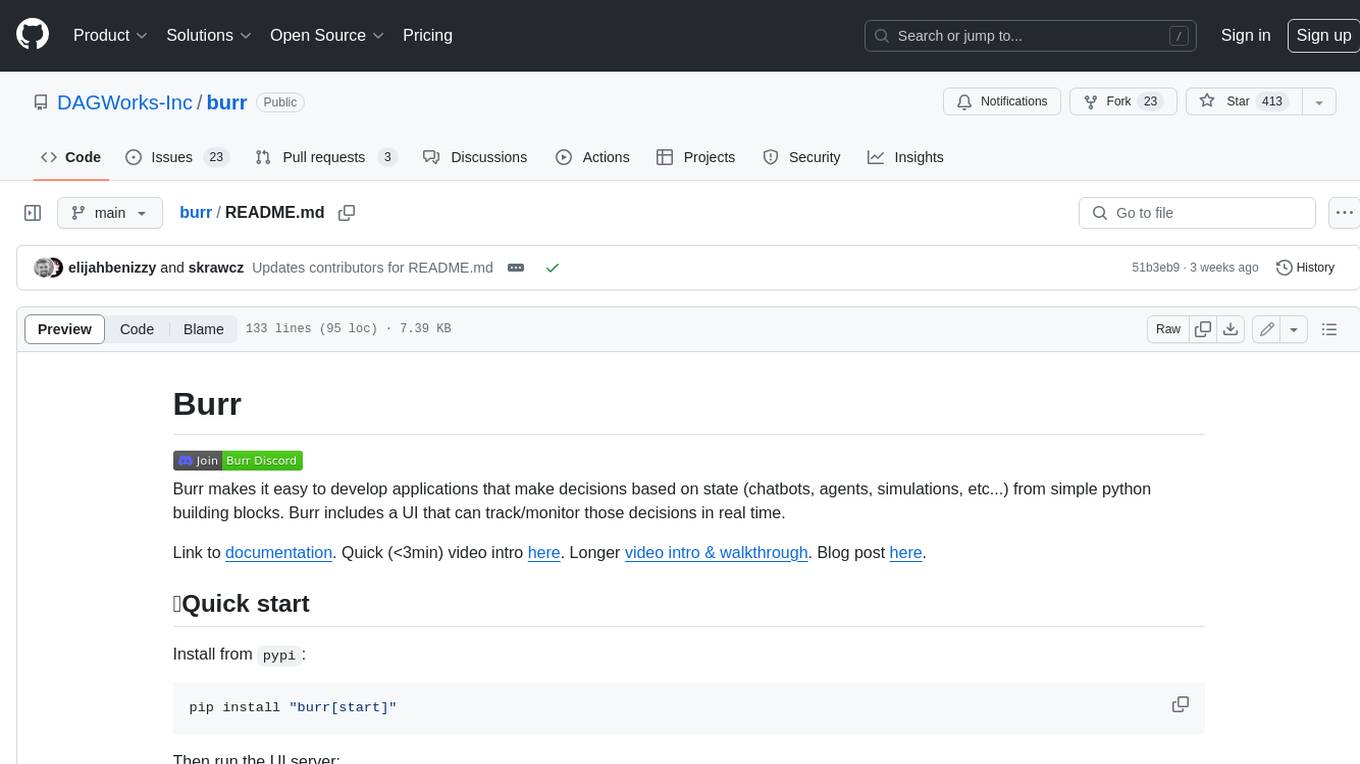
Burr is a Python library and UI that makes it easy to develop applications that make decisions based on state (chatbots, agents, simulations, etc...). Burr includes a UI that can track/monitor those decisions in real time.
README:
Burr makes it easy to develop applications that make decisions (chatbots, agents, simulations, etc...) from simple python building blocks.
Burr works well for any application that uses LLMs, and can integrate with any of your favorite frameworks. Burr includes a UI that can track/monitor/trace your system in real time, along with pluggable persisters (e.g. for memory) to save & load application state.
Link to documentation. Quick (<3min) video intro here. Longer video intro & walkthrough. Blog post here. Join discord for help/questions here.
Install from pypi:
pip install "burr[start]"(see the docs if you're using poetry)
Then run the UI server:
burrThis will open up Burr's telemetry UI. It comes loaded with some default data so you can click around.
It also has a demo chat application to help demonstrate what the UI captures enabling you too see things changing in
real-time. Hit the "Demos" side bar on the left and select chatbot. To chat it requires the OPENAI_API_KEY
environment variable to be set, but you can still see how it works if you don't have an API key set.
Next, start coding / running examples:
git clone https://github.com/dagworks-inc/burr && cd burr/examples/hello-world-counter
python application.pyYou'll see the counter example running in the terminal, along with the trace being tracked in the UI. See if you can find it.
For more details see the getting started guide.
With Burr you express your application as a state machine (i.e. a graph/flowchart). You can (and should!) use it for anything in which you have to manage state, track complex decisions, add human feedback, or dictate an idempotent, self-persisting workflow.
The core API is simple -- the Burr hello-world looks like this (plug in your own LLM, or copy from the docs for gpt-X)
from burr.core import action, State, ApplicationBuilder
@action(reads=[], writes=["prompt", "chat_history"])
def human_input(state: State, prompt: str) -> State:
# your code -- write what you want here, for example
chat_item = {"role" : "user", "content" : prompt}
return state.update(prompt=prompt).append(chat_history=chat_item)
@action(reads=["chat_history"], writes=["response", "chat_history"])
def ai_response(state: State) -> State:
# query the LLM however you want (or don't use an LLM, up to you...)
response = _query_llm(state["chat_history"]) # Burr doesn't care how you use LLMs!
chat_item = {"role" : "system", "content" : response}
return state.update(response=content).append(chat_history=chat_item)
app = (
ApplicationBuilder()
.with_actions(human_input, ai_response)
.with_transitions(
("human_input", "ai_response"),
("ai_response", "human_input")
).with_state(chat_history=[])
.with_entrypoint("human_input")
.build()
)
*_, state = app.run(halt_after=["ai_response"], inputs={"prompt": "Who was Aaron Burr, sir?"})
print("answer:", app.state["response"])Burr includes:
- A (dependency-free) low-abstraction python library that enables you to build and manage state machines with simple python functions
- A UI you can use view execution telemetry for introspection and debugging
- A set of integrations to make it easier to persist state, connect to telemetry, and integrate with other systems
Burr can be used to power a variety of applications, including:
- A simple gpt-like chatbot
- A stateful RAG-based chatbot
- An LLM-based adventure game
- An interactive assistant for writing emails
As well as a variety of (non-LLM) use-cases, including a time-series forecasting simulation, and hyperparameter tuning.
And a lot more!
Using hooks and other integrations you can (a) integrate with any of your favorite vendors (LLM observability, storage, etc...), and (b) build custom actions that delegate to your favorite libraries (like Hamilton).
Burr will not tell you how to build your models, how to query APIs, or how to manage your data. It will help you tie all these together in a way that scales with your needs and makes following the logic of your system easy. Burr comes out of the box with a host of integrations including tooling to build a UI in streamlit and watch your state machine execute.
See the documentation for getting started, and follow the example. Then read through some of the concepts and write your own application!
While Burr is attempting something (somewhat) unique, there are a variety of tools that occupy similar spaces:
| Criteria | Burr | Langgraph | temporal | Langchain | Superagent | Hamilton |
|---|---|---|---|---|---|---|
| Explicitly models a state machine | ✅ | ✅ | ❌ | ❌ | ❌ | ❌ |
| Framework-agnostic | ✅ | ✅ | ✅ | ✅ | ❌ | ✅ |
| Asynchronous event-based orchestration | ❌ | ❌ | ✅ | ❌ | ❌ | ❌ |
| Built for core web-service logic | ✅ | ✅ | ❌ | ✅ | ✅ | ✅ |
| Open-source user-interface for monitoring/tracing | ✅ | ❌ | ❌ | ❌ | ❌ | ✅ |
| Works with non-LLM use-cases | ✅ | ❌ | ❌ | ❌ | ❌ | ✅ |
Burr is named after Aaron Burr, founding father, third VP of the United States, and murderer/arch-nemesis of Alexander Hamilton. What's the connection with Hamilton? This is DAGWorks' second open-source library release after the Hamilton library We imagine a world in which Burr and Hamilton lived in harmony and saw through their differences to better the union. We originally built Burr as a harness to handle state between executions of Hamilton DAGs (because DAGs don't have cycles), but realized that it has a wide array of applications and decided to release it more broadly.
"After evaluating several other obfuscating LLM frameworks, their elegant yet comprehensive state management solution proved to be the powerful answer to rolling out robots driven by AI decision-making."
Ashish Ghosh CTO, Peanut Robotics
"Of course, you can use it [LangChain], but whether it's really production-ready and improves the time from 'code-to-prod' [...], we've been doing LLM apps for two years, and the answer is no [...] All these 'all-in-one' libs suffer from this [...]. Honestly, take a look at Burr. Thank me later."
Reddit user cyan2k LocalLlama, Subreddit
"Using Burr is a no-brainer if you want to build a modular AI application. It is so easy to build with, and I especially love their UI which makes debugging a piece of cake. And the always-ready-to-help team is the cherry on top."
Ishita Founder, Watto.ai
"I just came across Burr and I'm like WOW, this seems like you guys predicted this exact need when building this. No weird esoteric concepts just because it's AI."
Matthew Rideout Staff Software Engineer, Paxton AI
"Burr's state management part is really helpful for creating state snapshots and building debugging, replaying, and even evaluation cases around that."
Rinat Gareev Senior Solutions Architect, Provectus
"I have been using Burr over the past few months, and compared to many agentic LLM platforms out there (e.g. LangChain, CrewAi, AutoGen, Agency Swarm, etc), Burr provides a more robust framework for designing complex behaviors."
Hadi Nayebi Co-founder, CognitiveGraphs
"Moving from LangChain to Burr was a game-changer!
- Time-Saving: It took me just a few hours to get started with Burr, compared to the days and weeks I spent trying to navigate LangChain.
- Cleaner Implementation: With Burr, I could finally have a cleaner, more sophisticated, and stable implementation. No more wrestling with complex codebases.
- Team Adoption: I pitched Burr to my teammates, and we pivoted our entire codebase to it. It's been a smooth ride ever since."
Aditya K. DS Architect, TaskHuman
While Burr is stable and well-tested, we have quite a few tools/features on our roadmap!
- FastAPI integration + hosted deployment -- make it really easy to get Burr in an app in production without thinking about REST APIs
- Various efficiency/usability improvements for the core library (see planned capabilities for more details). This includes:
- First-class support for retries + exception management
- More integration with popular frameworks (LCEL, LLamaIndex, Hamilton, etc...)
- Capturing & surfacing extra metadata, e.g. annotations for particular point in time, that you can then pull out for fine-tuning, etc.
- Improvements to the pydantic-based typing system
- Tooling for hosted execution of state machines, integrating with your infrastructure (Ray, modal, FastAPI + EC2, etc...)
- Additional storage integrations. More integrations with technologies like MySQL, S3, etc. so you can run Burr on top of what you have available.
If you want to avoid self-hosting the above solutions we're building Burr Cloud. To let us know you're interested sign up here for the waitlist to get access.
We welcome contributors! To get started on developing, see the developer-facing docs.
Users who have contributed core functionality, integrations, or examples.
Users who have contributed small docs fixes, design suggestions, and found bugs
For Tasks:
Click tags to check more tools for each tasksFor Jobs:
Alternative AI tools for burr
Similar Open Source Tools

burr
Burr is a Python library and UI that makes it easy to develop applications that make decisions based on state (chatbots, agents, simulations, etc...). Burr includes a UI that can track/monitor those decisions in real time.
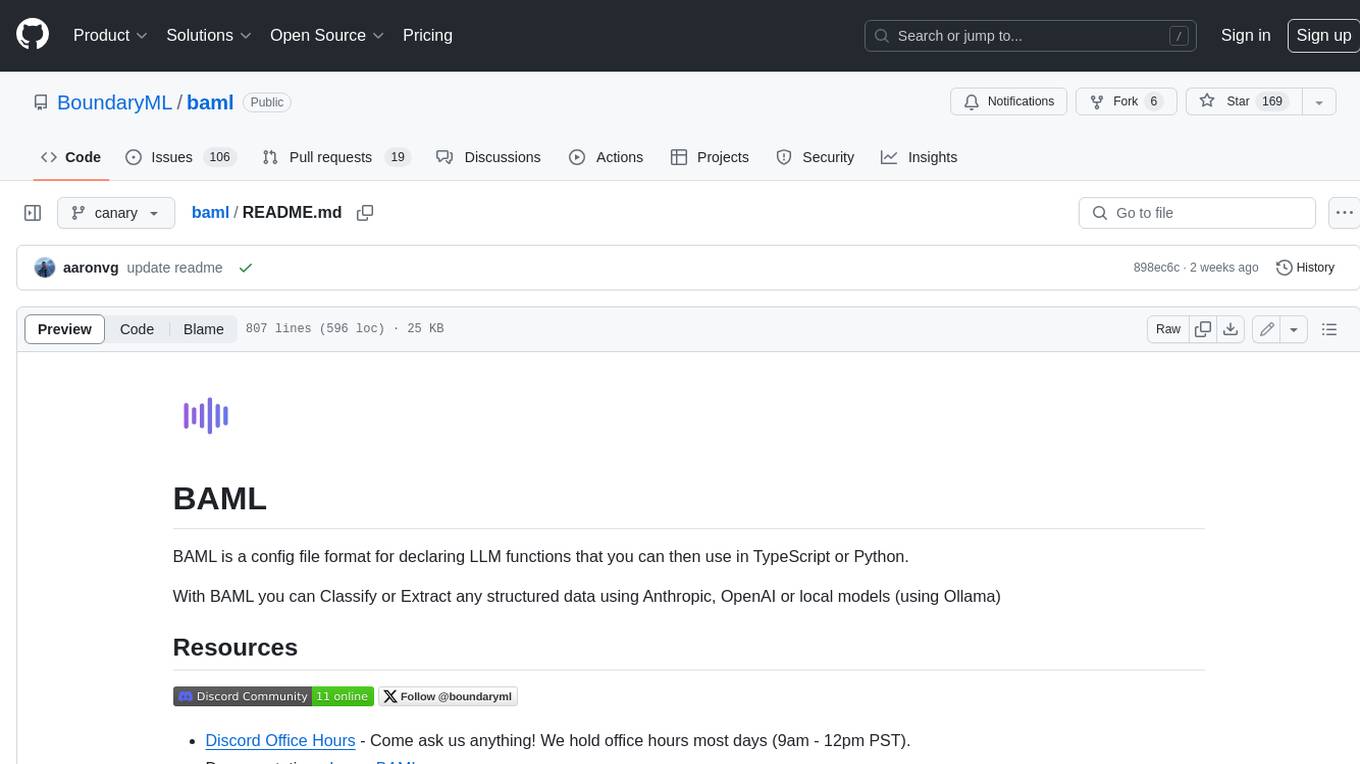
baml
BAML is a config file format for declaring LLM functions that you can then use in TypeScript or Python. With BAML you can Classify or Extract any structured data using Anthropic, OpenAI or local models (using Ollama) ## Resources  [Discord Community](https://discord.gg/boundaryml)  [Follow us on Twitter](https://twitter.com/boundaryml) * Discord Office Hours - Come ask us anything! We hold office hours most days (9am - 12pm PST). * Documentation - Learn BAML * Documentation - BAML Syntax Reference * Documentation - Prompt engineering tips * Boundary Studio - Observability and more #### Starter projects * BAML + NextJS 14 * BAML + FastAPI + Streaming ## Motivation Calling LLMs in your code is frustrating: * your code uses types everywhere: classes, enums, and arrays * but LLMs speak English, not types BAML makes calling LLMs easy by taking a type-first approach that lives fully in your codebase: 1. Define what your LLM output type is in a .baml file, with rich syntax to describe any field (even enum values) 2. Declare your prompt in the .baml config using those types 3. Add additional LLM config like retries or redundancy 4. Transpile the .baml files to a callable Python or TS function with a type-safe interface. (VSCode extension does this for you automatically). We were inspired by similar patterns for type safety: protobuf and OpenAPI for RPCs, Prisma and SQLAlchemy for databases. BAML guarantees type safety for LLMs and comes with tools to give you a great developer experience:  Jump to BAML code or how Flexible Parsing works without additional LLM calls. | BAML Tooling | Capabilities | | ----------------------------------------------------------------------------------------- | ---------------------------------------------------------------------------------------------------------------------------------------------------------------------------------------------------------------------------------------------------------------------------------------------------------------------------------- | | BAML Compiler install | Transpiles BAML code to a native Python / Typescript library (you only need it for development, never for releases) Works on Mac, Windows, Linux  | | VSCode Extension install | Syntax highlighting for BAML files Real-time prompt preview Testing UI | | Boundary Studio open (not open source) | Type-safe observability Labeling |
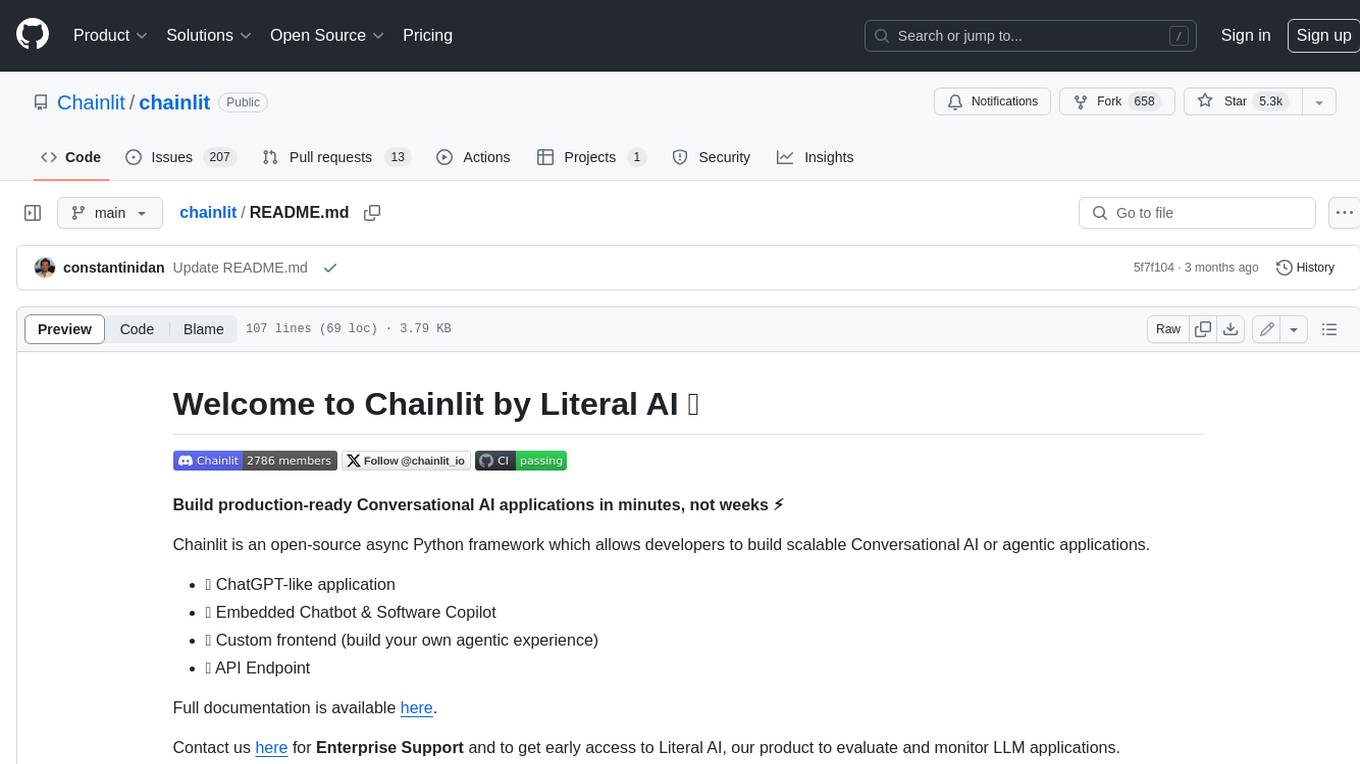
chainlit
Chainlit is an open-source async Python framework which allows developers to build scalable Conversational AI or agentic applications. It enables users to create ChatGPT-like applications, embedded chatbots, custom frontends, and API endpoints. The framework provides features such as multi-modal chats, chain of thought visualization, data persistence, human feedback, and an in-context prompt playground. Chainlit is compatible with various Python programs and libraries, including LangChain, Llama Index, Autogen, OpenAI Assistant, and Haystack. It offers a range of examples and a cookbook to showcase its capabilities and inspire users. Chainlit welcomes contributions and is licensed under the Apache 2.0 license.
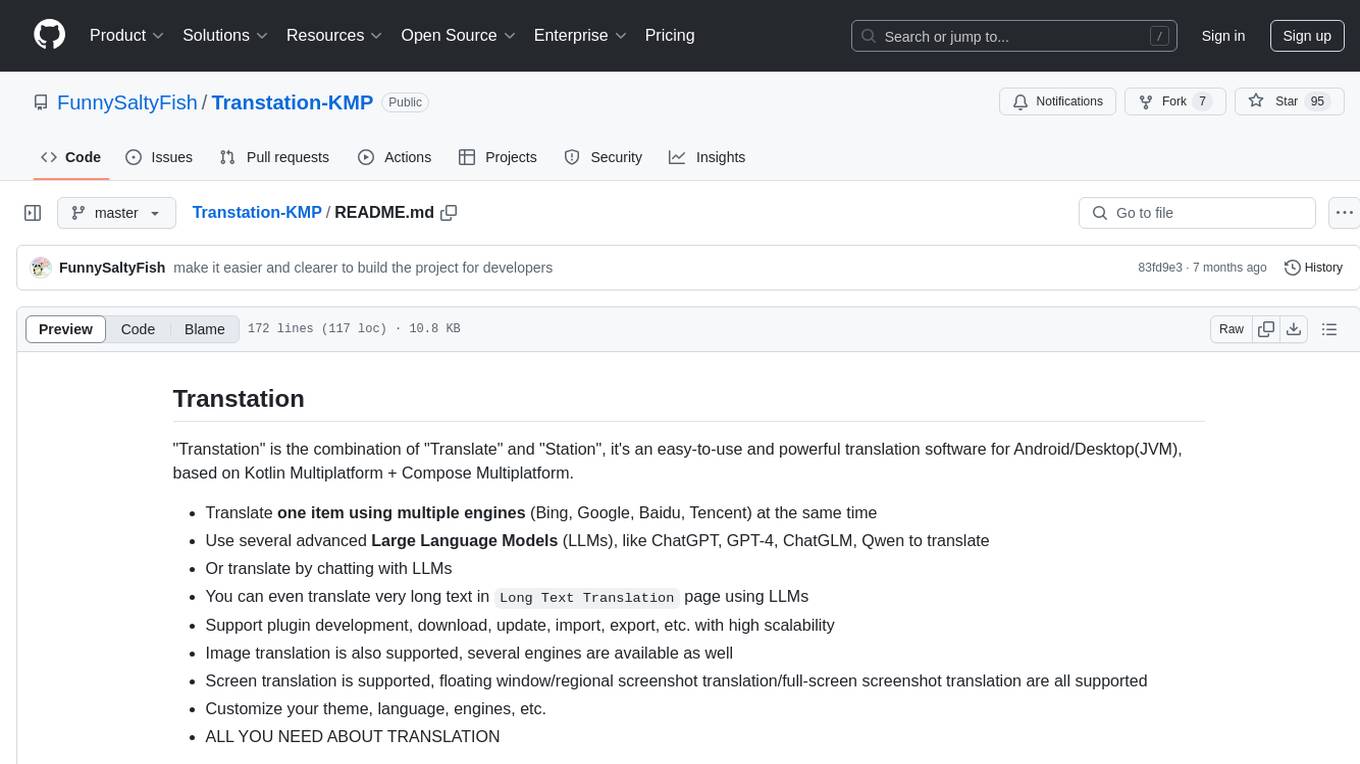
Transtation-KMP
Transtation is an easy-to-use and powerful translation software for Android/Desktop based on Kotlin Multiplatform + Compose Multiplatform. It allows users to translate one item using multiple engines simultaneously, utilize advanced Large Language Models for translation, chat with LLMs for translation, translate long text, support plugin development, image translation, and screen translation. The application is designed for Chinese users and serves as a reference for learning Jetpack Compose or Compose Multiplatform. It features Kotlin Multiplatform, Compose Multiplatform, MVVM, Kotlin Coroutine, Flow, SqlDelight, synchronized translation with multiple engines, plugin development, and makes use of Kotlin language features like lazy loading, Coroutine, sealed classes, and reflection. The application gradually adapts to Android13 with features like setting application language separately and supporting Monet icon.
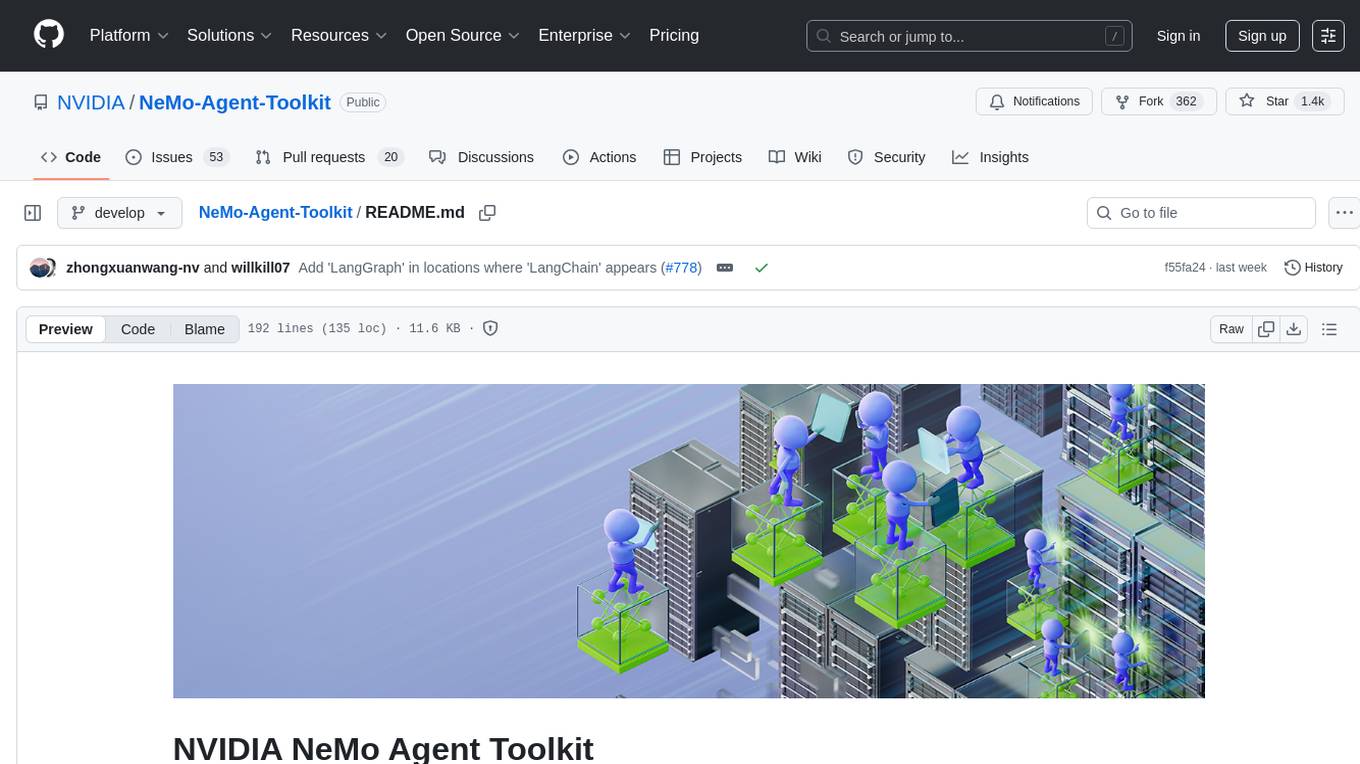
NeMo-Agent-Toolkit
NVIDIA NeMo Agent toolkit is a flexible, lightweight, and unifying library that allows you to easily connect existing enterprise agents to data sources and tools across any framework. It is framework agnostic, promotes reusability, enables rapid development, provides profiling capabilities, offers observability features, includes an evaluation system, features a user interface for interaction, and supports the Model Context Protocol (MCP). With NeMo Agent toolkit, users can move quickly, experiment freely, and ensure reliability across all agent-driven projects.
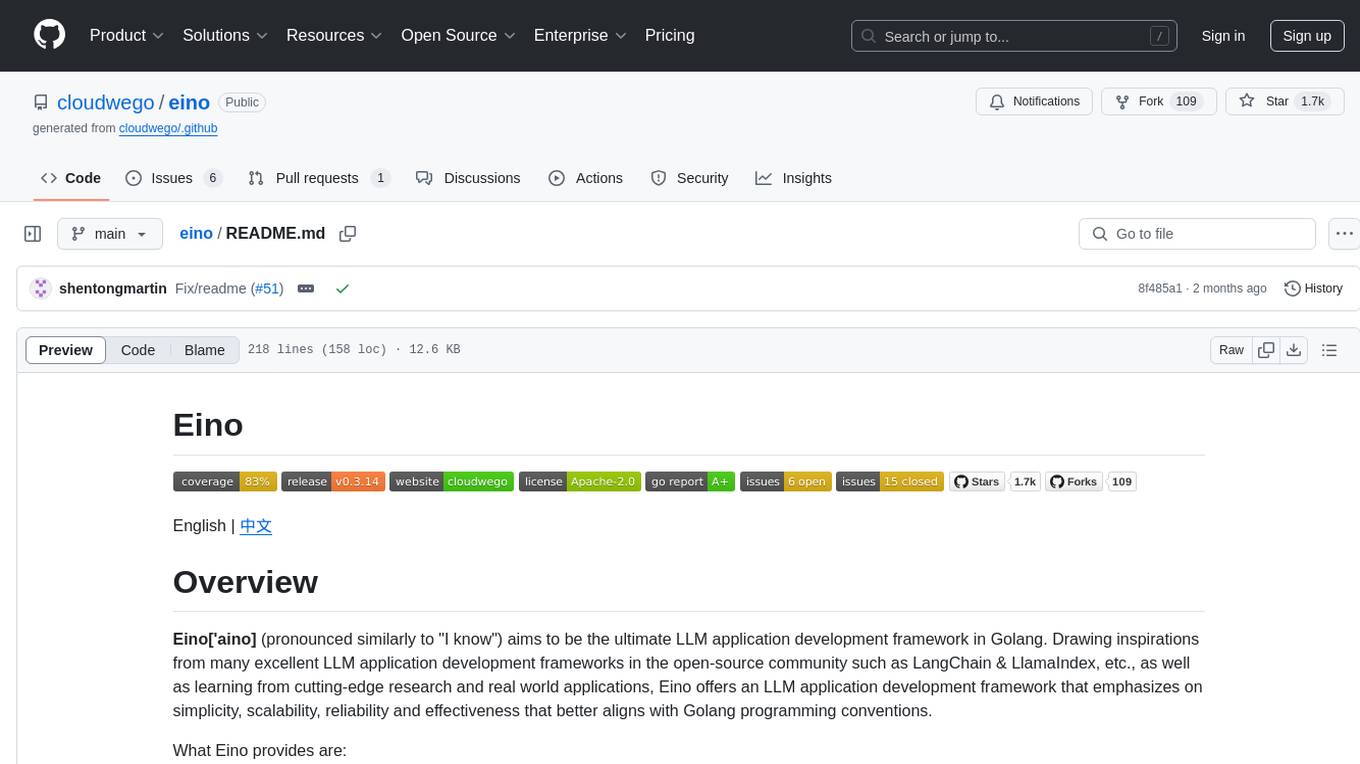
eino
Eino is an ultimate LLM application development framework in Golang, emphasizing simplicity, scalability, reliability, and effectiveness. It provides a curated list of component abstractions, a powerful composition framework, meticulously designed APIs, best practices, and tools covering the entire development cycle. Eino standardizes and improves efficiency in AI application development by offering rich components, powerful orchestration, complete stream processing, highly extensible aspects, and a comprehensive framework structure.
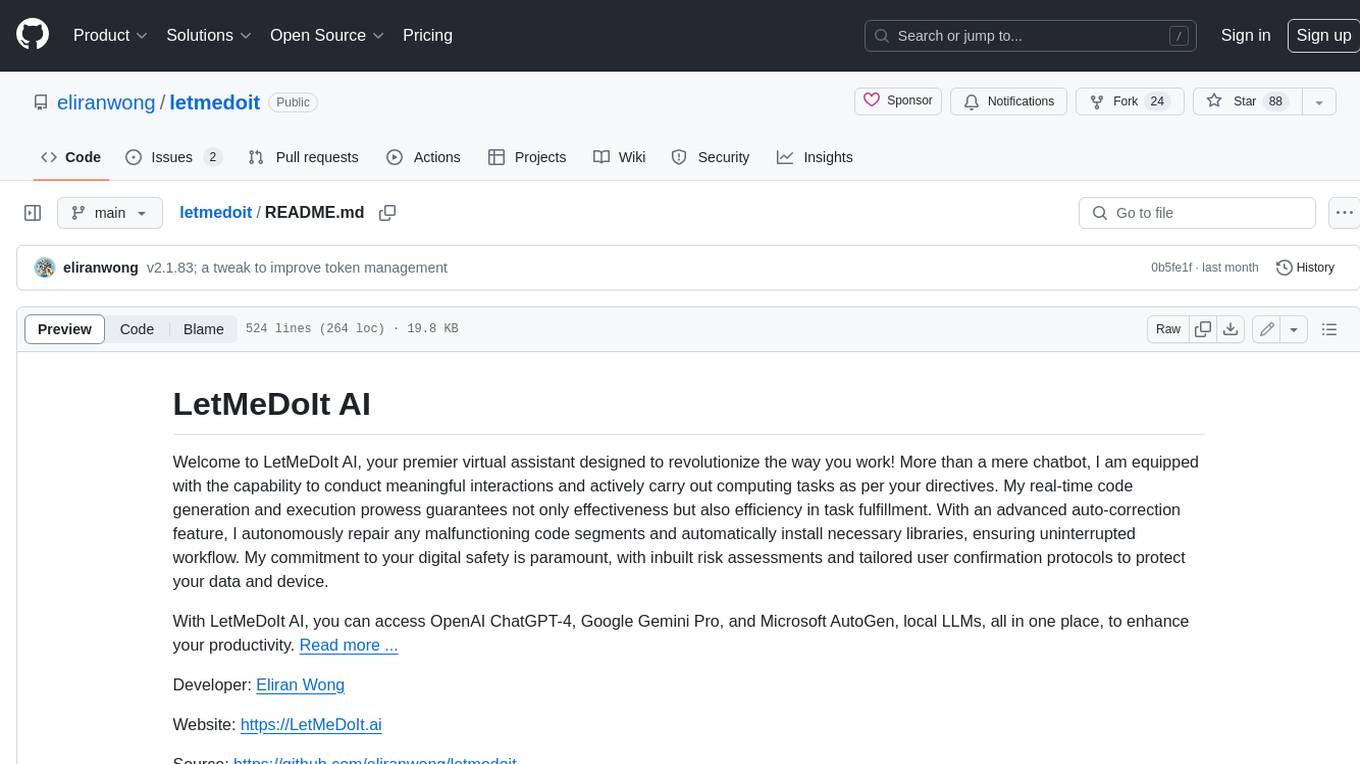
letmedoit
LetMeDoIt AI is a virtual assistant designed to revolutionize the way you work. It goes beyond being a mere chatbot by offering a unique and powerful capability - the ability to execute commands and perform computing tasks on your behalf. With LetMeDoIt AI, you can access OpenAI ChatGPT-4, Google Gemini Pro, and Microsoft AutoGen, local LLMs, all in one place, to enhance your productivity.
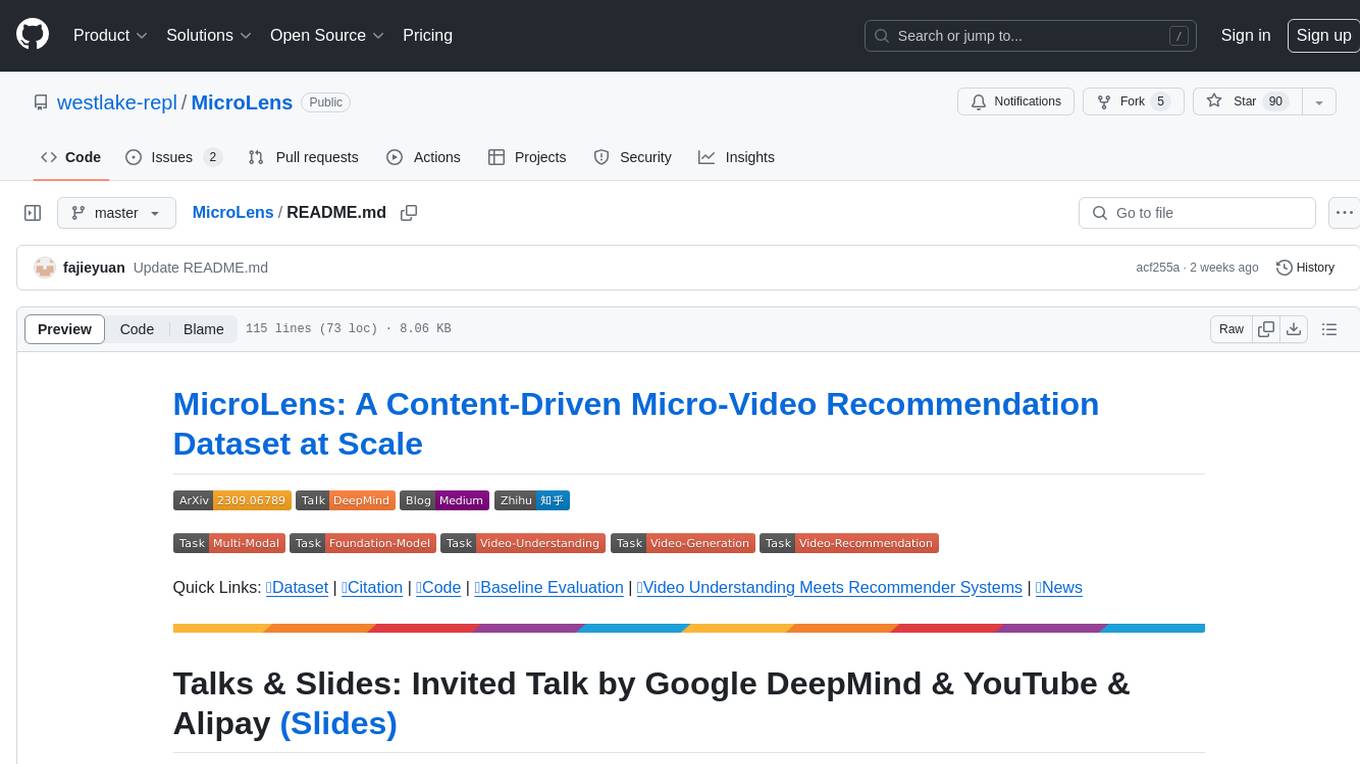
MicroLens
MicroLens is a content-driven micro-video recommendation dataset at scale. It provides a large dataset with multimodal data, including raw text, images, audio, video, and video comments, for tasks such as multi-modal recommendation, foundation model building, and fairness recommendation. The dataset is available in two versions: MicroLens-50K and MicroLens-100K, with extracted features for multimodal recommendation tasks. Researchers can access the dataset through provided links and reach out to the corresponding author for the complete dataset. The repository also includes codes for various algorithms like VideoRec, IDRec, and VIDRec, each implementing different video models and baselines.
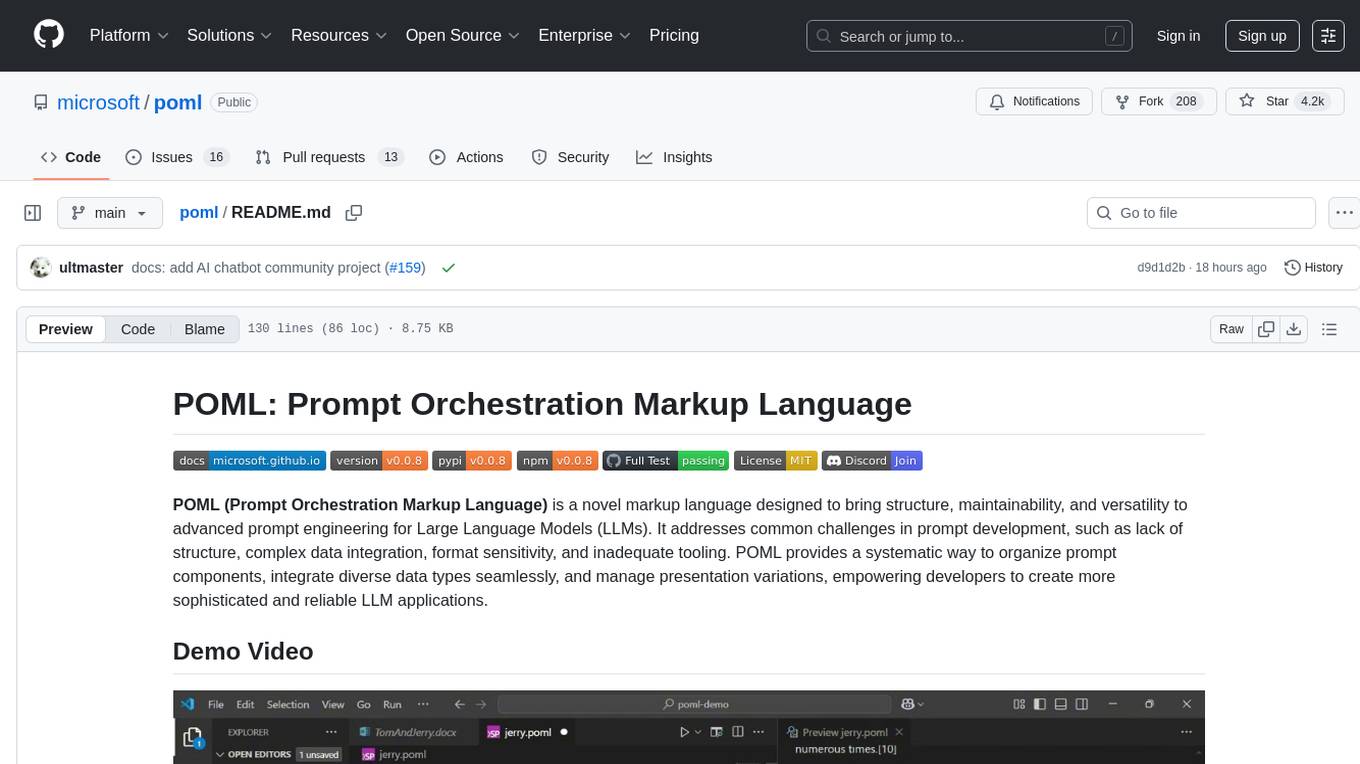
poml
POML (Prompt Orchestration Markup Language) is a novel markup language designed to bring structure, maintainability, and versatility to advanced prompt engineering for Large Language Models (LLMs). It addresses common challenges in prompt development, such as lack of structure, complex data integration, format sensitivity, and inadequate tooling. POML provides a systematic way to organize prompt components, integrate diverse data types seamlessly, and manage presentation variations, empowering developers to create more sophisticated and reliable LLM applications.
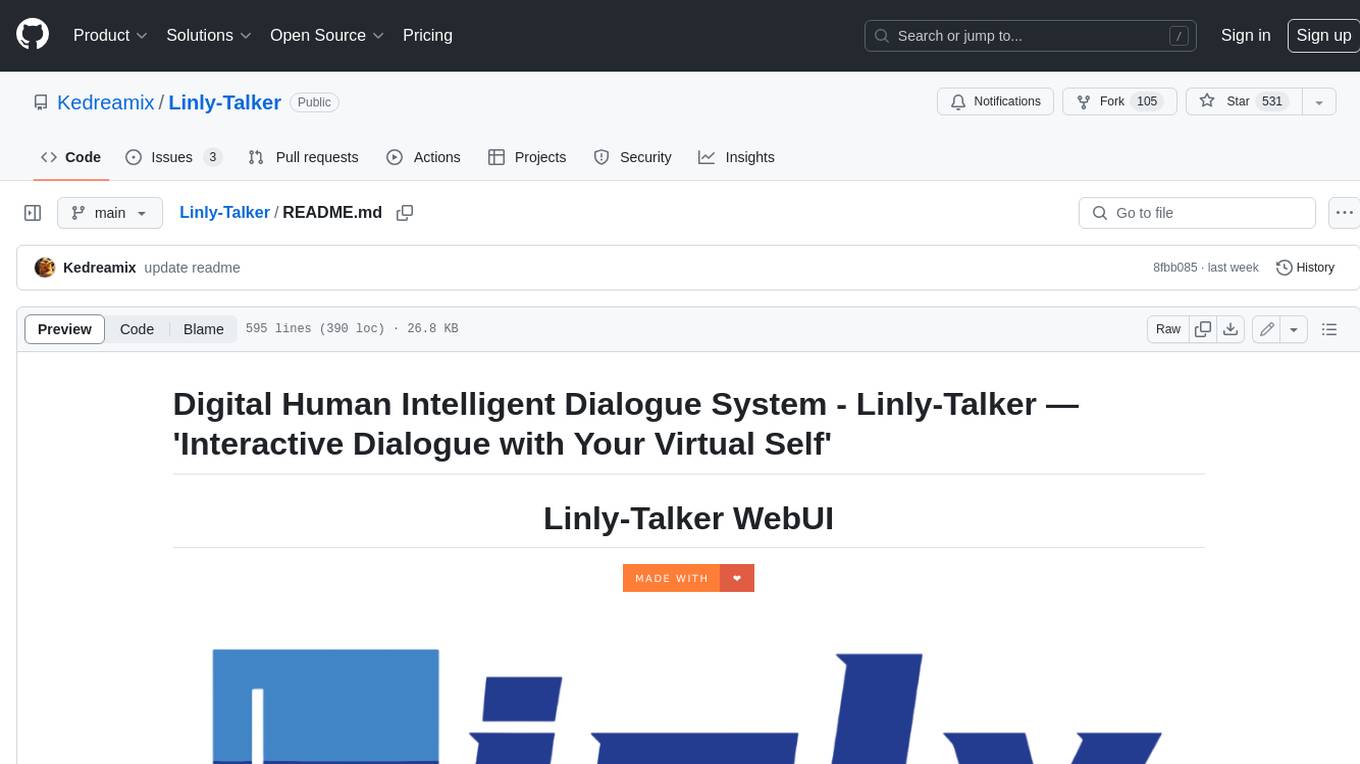
Linly-Talker
Linly-Talker is an innovative digital human conversation system that integrates the latest artificial intelligence technologies, including Large Language Models (LLM) 🤖, Automatic Speech Recognition (ASR) 🎙️, Text-to-Speech (TTS) 🗣️, and voice cloning technology 🎤. This system offers an interactive web interface through the Gradio platform 🌐, allowing users to upload images 📷 and engage in personalized dialogues with AI 💬.
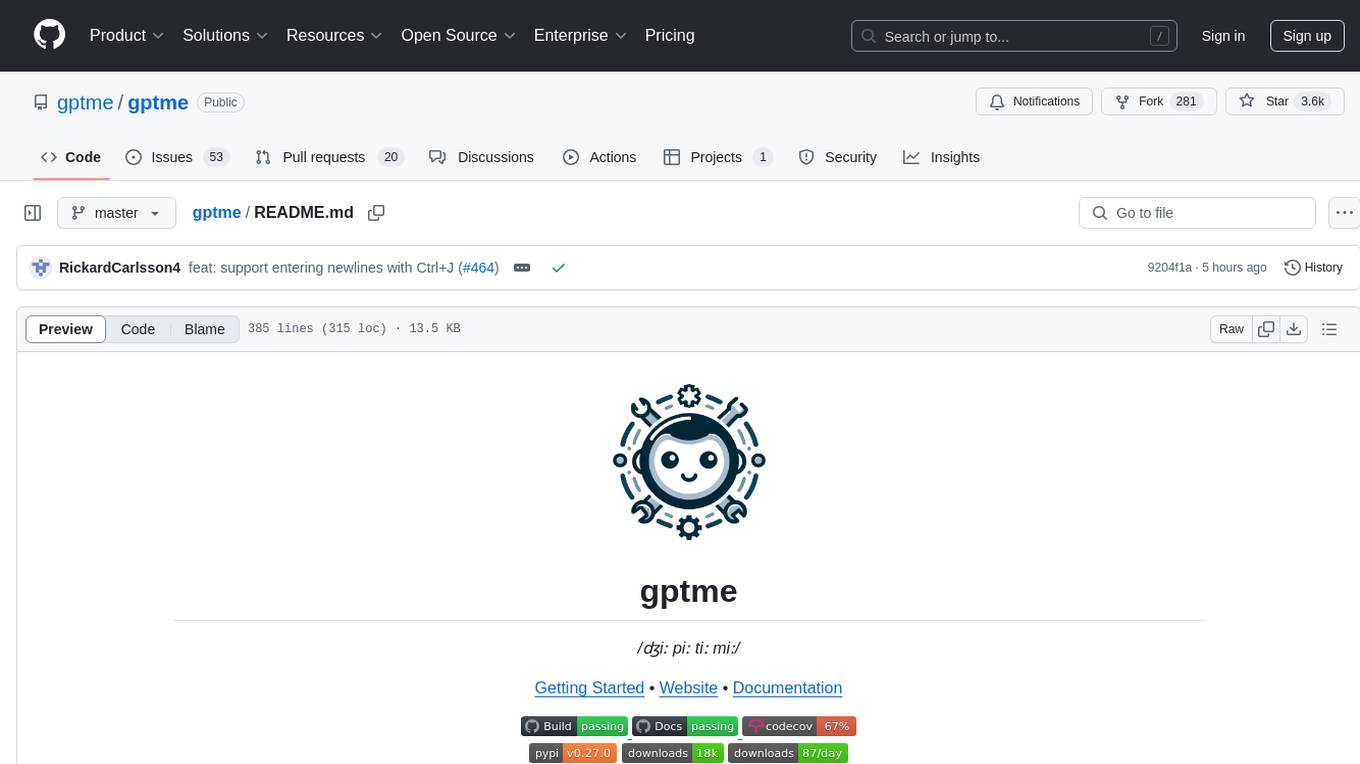
gptme
Personal AI assistant/agent in your terminal, with tools for using the terminal, running code, editing files, browsing the web, using vision, and more. A great coding agent that is general-purpose to assist in all kinds of knowledge work, from a simple but powerful CLI. An unconstrained local alternative to ChatGPT with 'Code Interpreter', Cursor Agent, etc. Not limited by lack of software, internet access, timeouts, or privacy concerns if using local models.
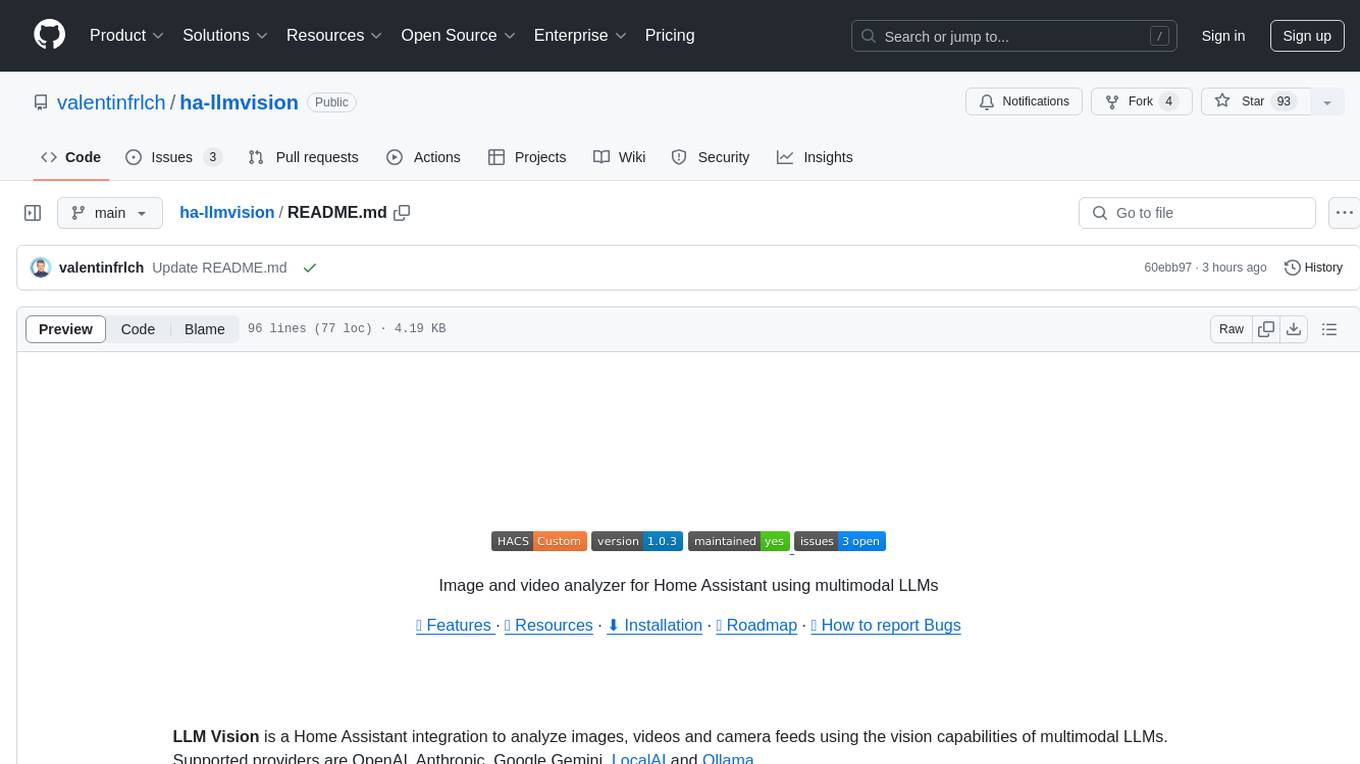
ha-llmvision
LLM Vision is a Home Assistant integration that allows users to analyze images, videos, and camera feeds using multimodal LLMs. It supports providers such as OpenAI, Anthropic, Google Gemini, LocalAI, and Ollama. Users can input images and videos from camera entities or local files, with the option to downscale images for faster processing. The tool provides detailed instructions on setting up LLM Vision and each supported provider, along with usage examples and service call parameters.
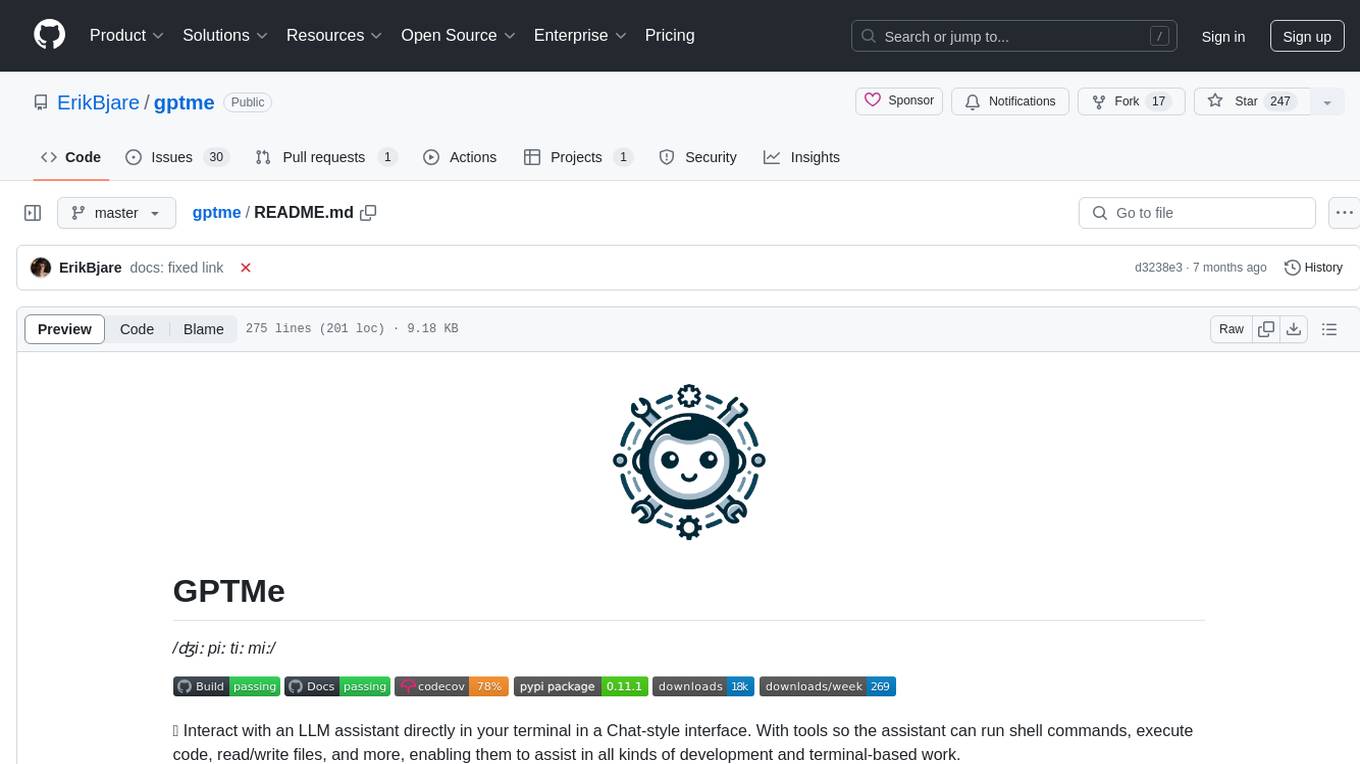
gptme
GPTMe is a tool that allows users to interact with an LLM assistant directly in their terminal in a chat-style interface. The tool provides features for the assistant to run shell commands, execute code, read/write files, and more, making it suitable for various development and terminal-based tasks. It serves as a local alternative to ChatGPT's 'Code Interpreter,' offering flexibility and privacy when using a local model. GPTMe supports code execution, file manipulation, context passing, self-correction, and works with various AI models like GPT-4. It also includes a GitHub Bot for requesting changes and operates entirely in GitHub Actions. In progress features include handling long contexts intelligently, a web UI and API for conversations, web and desktop vision, and a tree-based conversation structure.
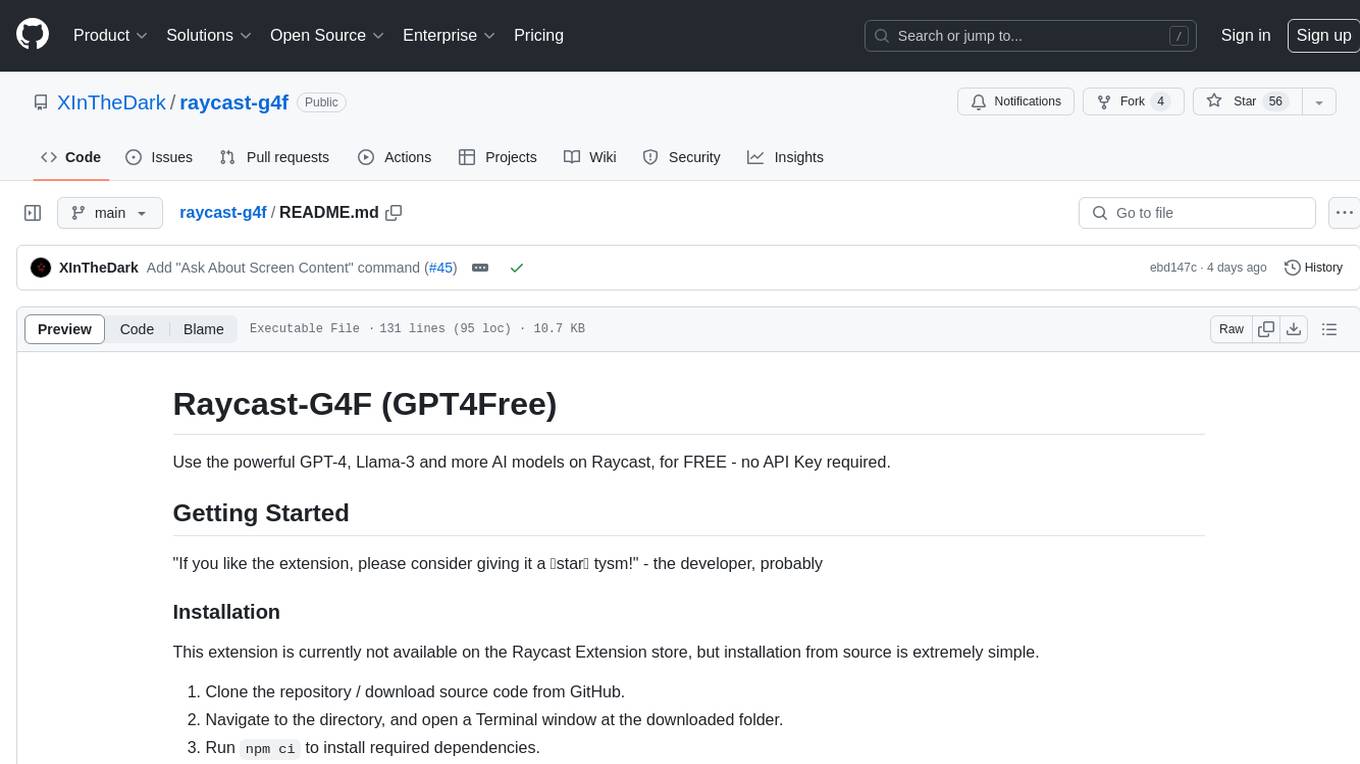
raycast-g4f
Raycast-G4F is a free extension that allows users to leverage powerful AI models such as GPT-4 and Llama-3 within the Raycast app without the need for an API key. The extension offers features like streaming support, diverse commands, chat interaction with AI, web search capabilities, file upload functionality, image generation, and custom AI commands. Users can easily install the extension from the source code and benefit from frequent updates and a user-friendly interface. Raycast-G4F supports various providers and models, each with different capabilities and performance ratings, ensuring a versatile AI experience for users.

pezzo
Pezzo is a fully cloud-native and open-source LLMOps platform that allows users to observe and monitor AI operations, troubleshoot issues, save costs and latency, collaborate, manage prompts, and deliver AI changes instantly. It supports various clients for prompt management, observability, and caching. Users can run the full Pezzo stack locally using Docker Compose, with prerequisites including Node.js 18+, Docker, and a GraphQL Language Feature Support VSCode Extension. Contributions are welcome, and the source code is available under the Apache 2.0 License.
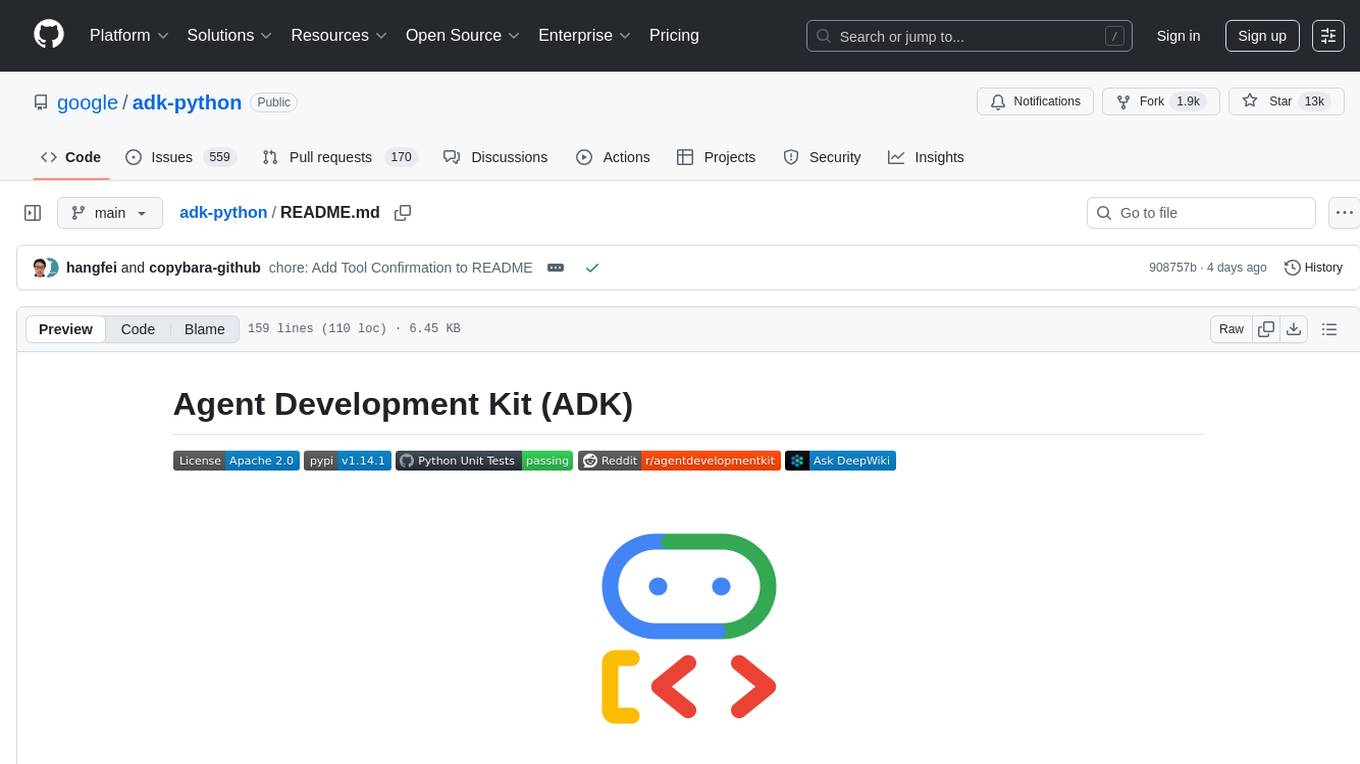
adk-python
Agent Development Kit (ADK) is an open-source, code-first Python toolkit for building, evaluating, and deploying sophisticated AI agents with flexibility and control. It is a flexible and modular framework optimized for Gemini and the Google ecosystem, but also compatible with other frameworks. ADK aims to make agent development feel more like software development, enabling developers to create, deploy, and orchestrate agentic architectures ranging from simple tasks to complex workflows.
For similar tasks

burr
Burr is a Python library and UI that makes it easy to develop applications that make decisions based on state (chatbots, agents, simulations, etc...). Burr includes a UI that can track/monitor those decisions in real time.
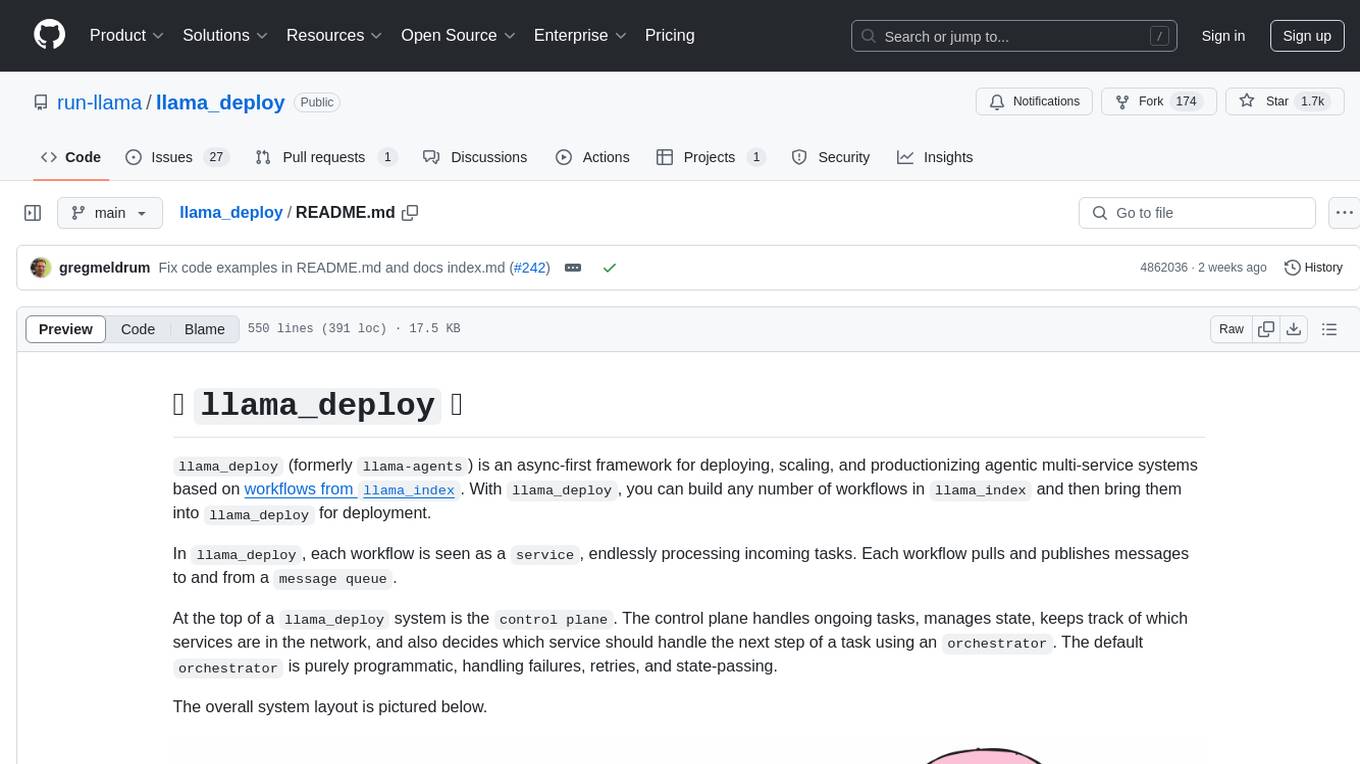
llama_deploy
llama_deploy is an async-first framework for deploying, scaling, and productionizing agentic multi-service systems based on workflows from llama_index. It allows building workflows in llama_index and deploying them seamlessly with minimal changes to code. The system includes services endlessly processing tasks, a control plane managing state and services, an orchestrator deciding task handling, and fault tolerance mechanisms. It is designed for high-concurrency scenarios, enabling real-time and high-throughput applications.
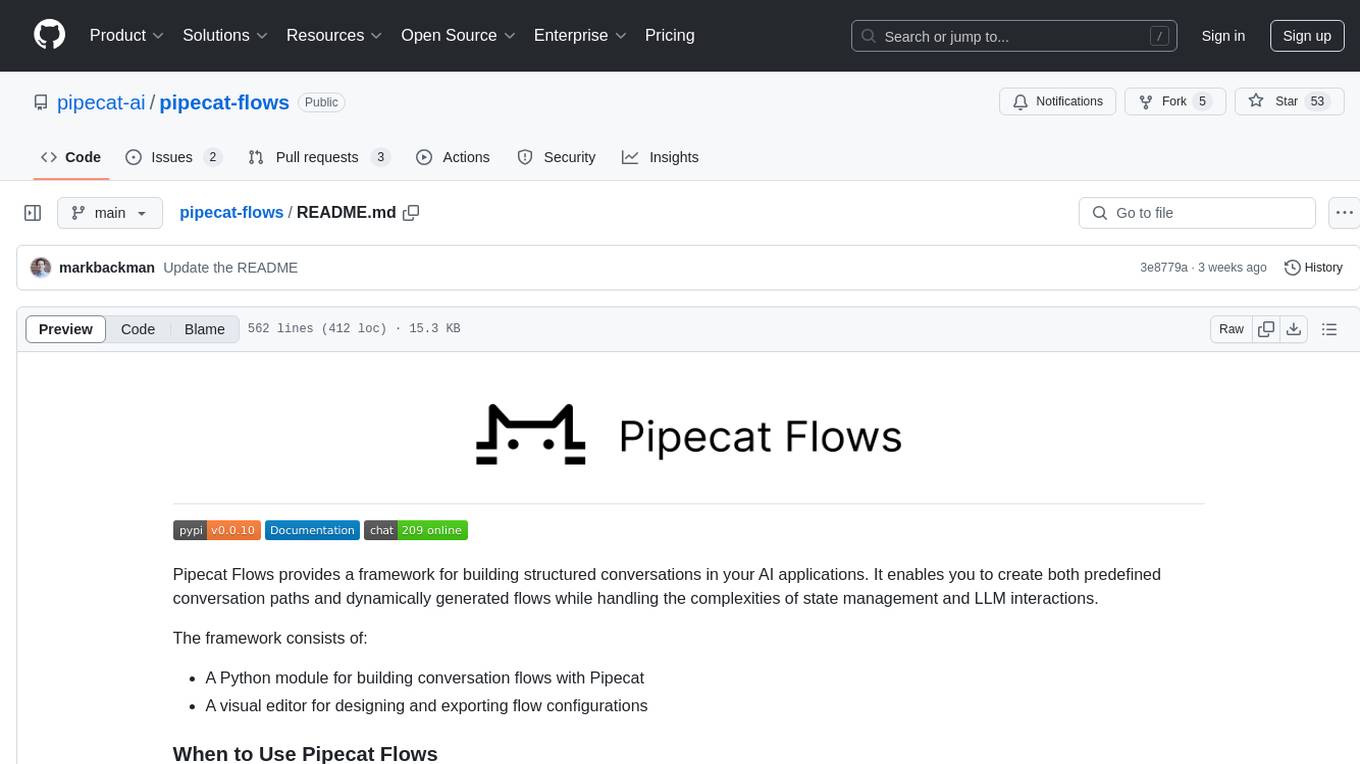
pipecat-flows
Pipecat Flows is a framework designed for building structured conversations in AI applications. It allows users to create both predefined conversation paths and dynamically generated flows, handling state management and LLM interactions. The framework includes a Python module for building conversation flows and a visual editor for designing and exporting flow configurations. Pipecat Flows is suitable for scenarios such as customer service scripts, intake forms, personalized experiences, and complex decision trees.
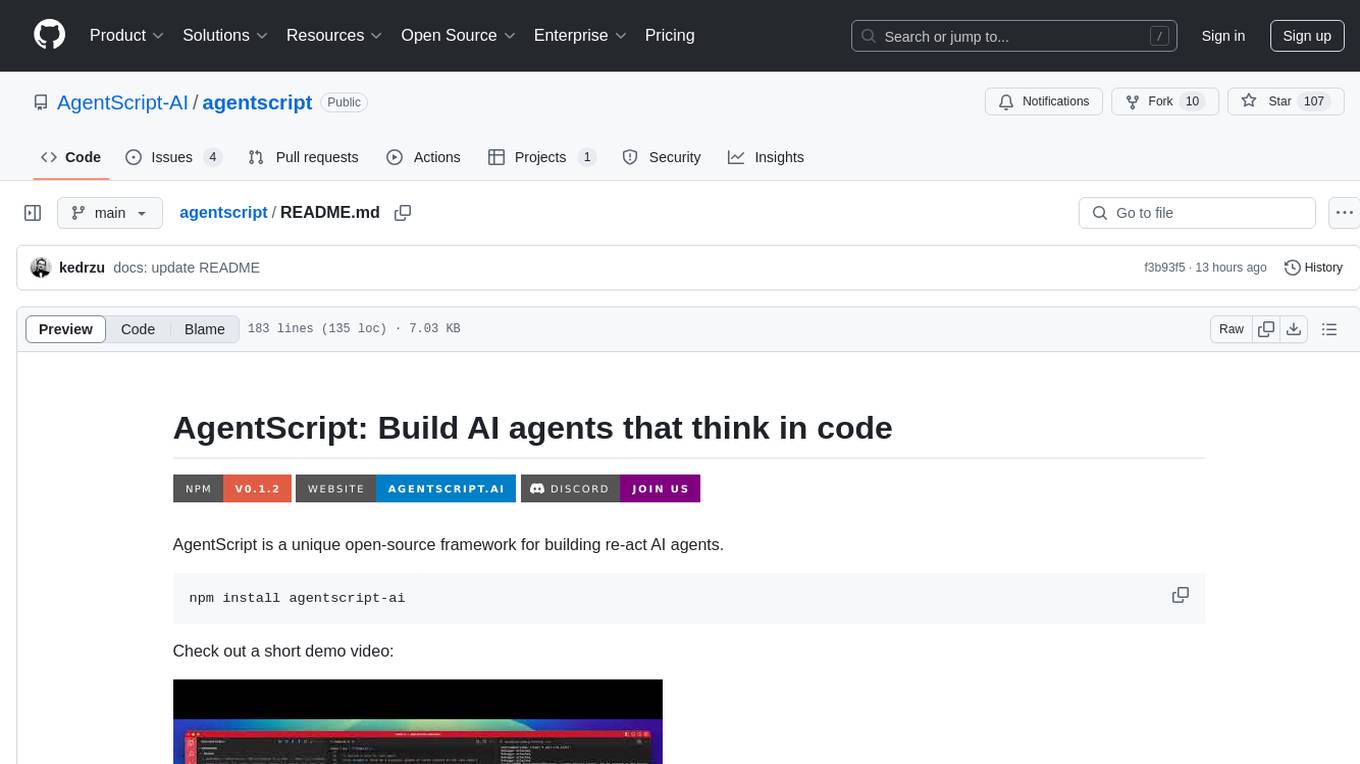
agentscript
AgentScript is an open-source framework for building AI agents that think in code. It prompts a language model to generate JavaScript code, which is then executed in a dedicated runtime with resumability, state persistence, and interactivity. The framework allows for abstract task execution without needing to know all the data beforehand, making it flexible and efficient. AgentScript supports tools, deterministic functions, and LLM-enabled functions, enabling dynamic data processing and decision-making. It also provides state management and human-in-the-loop capabilities, allowing for pausing, serialization, and resumption of execution.
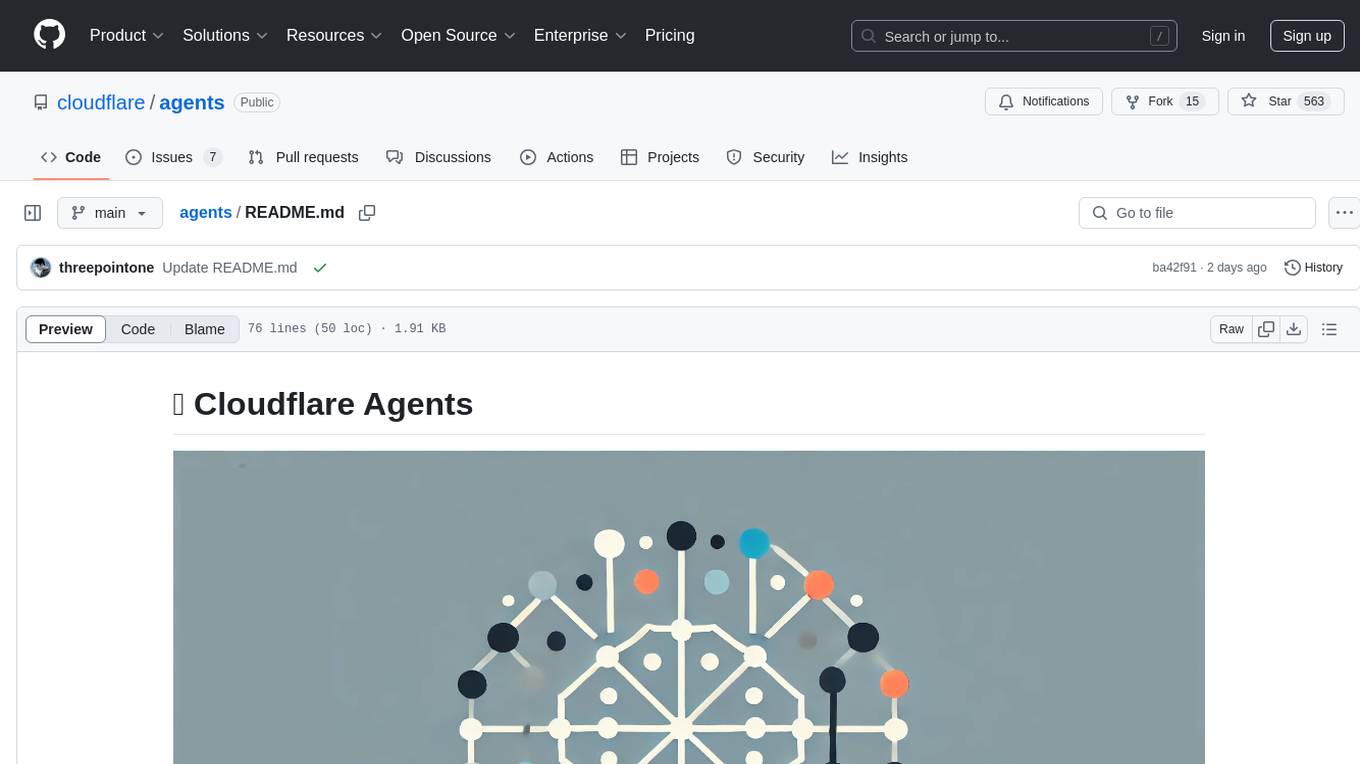
agents
Cloudflare Agents is a framework for building intelligent, stateful agents that persist, think, and evolve at the edge of the network. It allows for maintaining persistent state and memory, real-time communication, processing and learning from interactions, autonomous operation at global scale, and hibernating when idle. The project is actively evolving with focus on core agent framework, WebSocket communication, HTTP endpoints, React integration, and basic AI chat capabilities. Future developments include advanced memory systems, WebRTC for audio/video, email integration, evaluation framework, enhanced observability, and self-hosting guide.
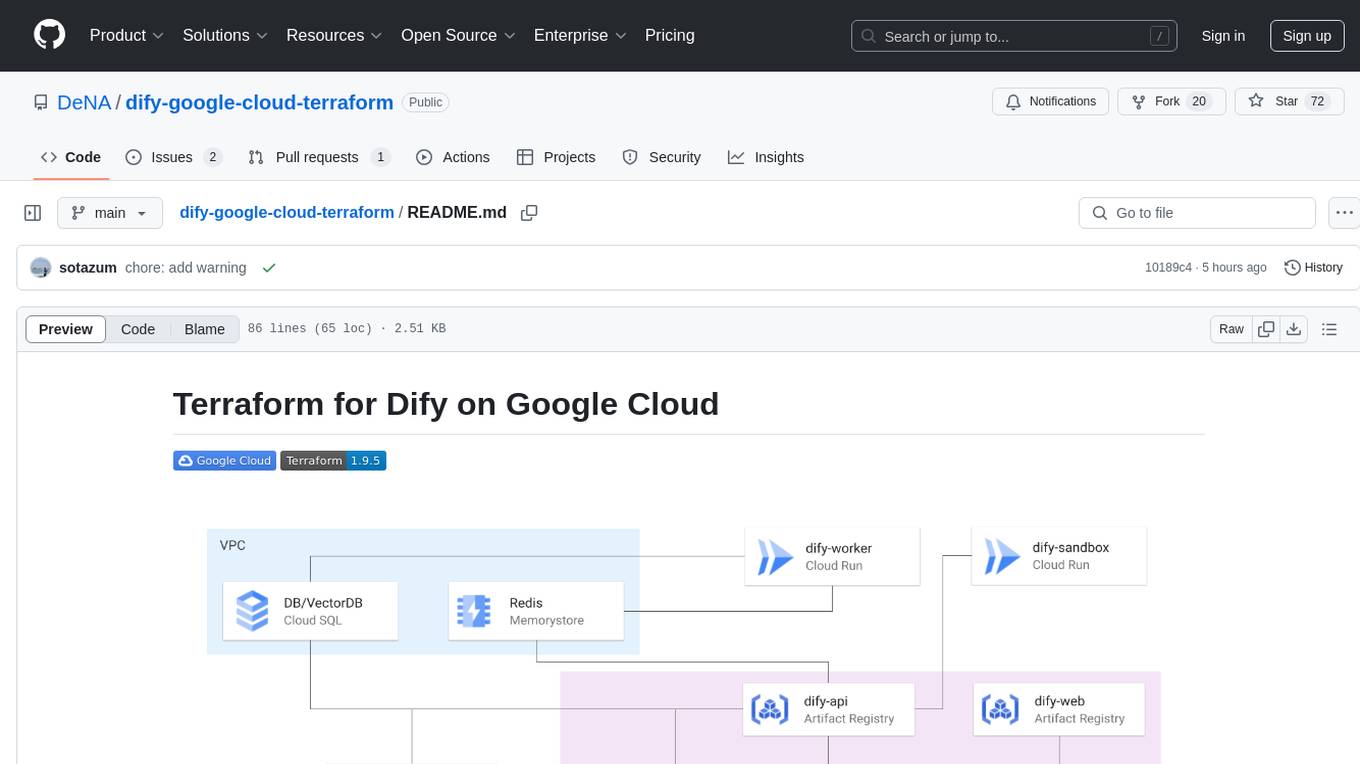
dify-google-cloud-terraform
This repository provides Terraform configurations to automatically set up Google Cloud resources and deploy Dify in a highly available configuration. It includes features such as serverless hosting, auto-scaling, and data persistence. Users need a Google Cloud account, Terraform, and gcloud CLI installed to use this tool. The configuration involves setting environment-specific values and creating a GCS bucket for managing Terraform state. The tool allows users to initialize Terraform, create Artifact Registry repository, build and push container images, plan and apply Terraform changes, and cleanup resources when needed.
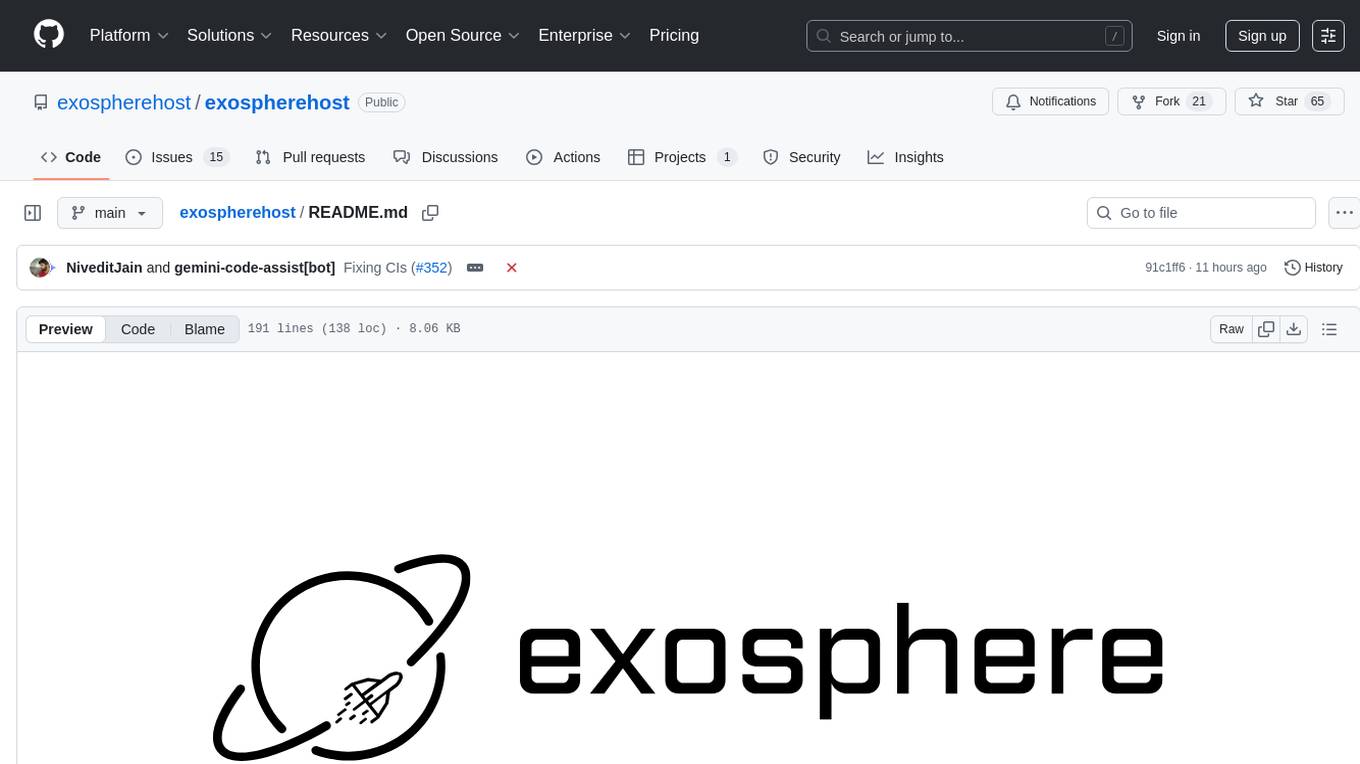
exospherehost
Exosphere is an open source infrastructure designed to run AI agents at scale for large data and long running flows. It allows developers to define plug and playable nodes that can be run on a reliable backbone in the form of a workflow, with features like dynamic state creation at runtime, infinite parallel agents, persistent state management, and failure handling. This enables the deployment of production agents that can scale beautifully to build robust autonomous AI workflows.

xpander.ai
xpander.ai is a Backend-as-a-Service for autonomous agents that abstracts the ops layer, allowing AI engineers to focus on behavior and outcomes. It provides managed agent hosting with version control and CI/CD, a fully managed PostgreSQL memory layer, and a library of 2,000+ functions. The platform features an AI native triggering system that processes inputs from various sources and delivers unified messages to agents. With support for any agent framework or SDK, including Agno and OpenAI, xpander.ai enables users to build intelligent, production-ready AI agents without dealing with infrastructure complexity.
For similar jobs

burr
Burr is a Python library and UI that makes it easy to develop applications that make decisions based on state (chatbots, agents, simulations, etc...). Burr includes a UI that can track/monitor those decisions in real time.
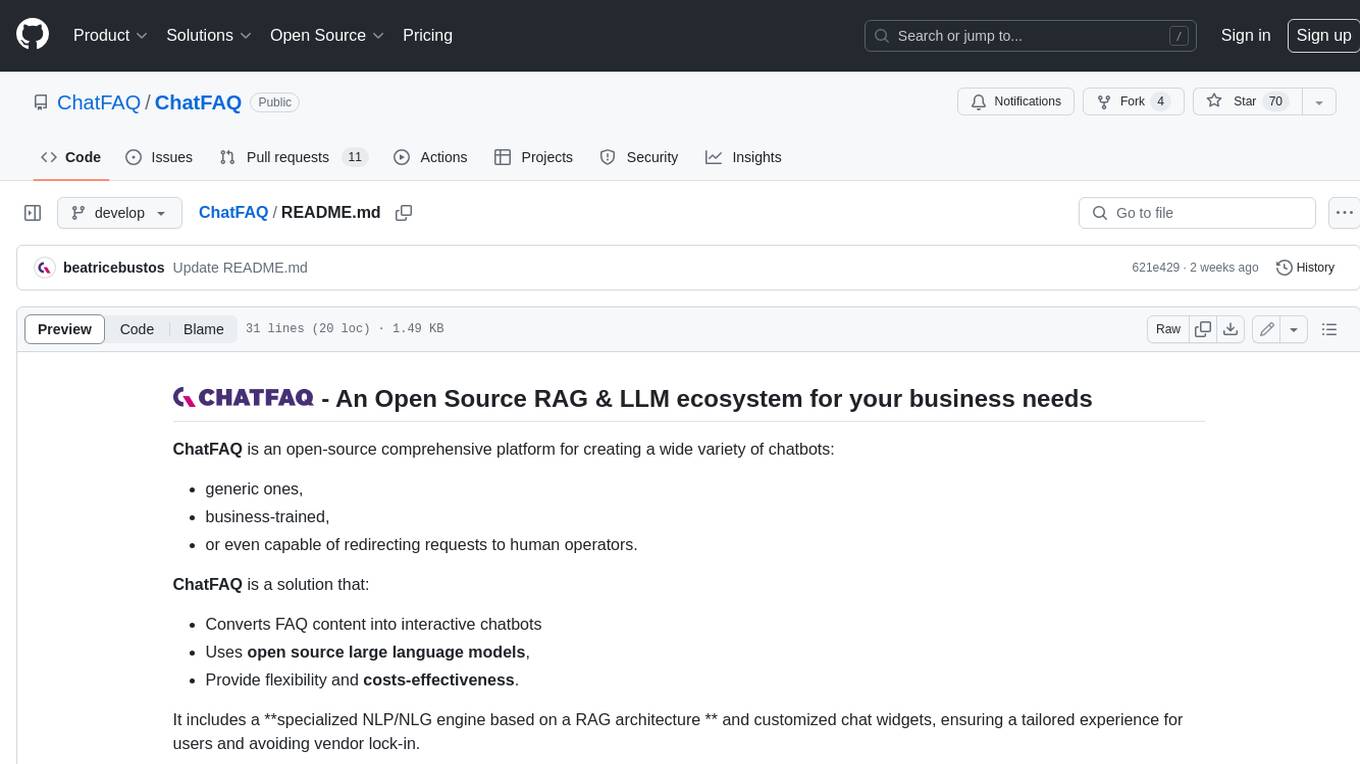
ChatFAQ
ChatFAQ is an open-source comprehensive platform for creating a wide variety of chatbots: generic ones, business-trained, or even capable of redirecting requests to human operators. It includes a specialized NLP/NLG engine based on a RAG architecture and customized chat widgets, ensuring a tailored experience for users and avoiding vendor lock-in.

agentcloud
AgentCloud is an open-source platform that enables companies to build and deploy private LLM chat apps, empowering teams to securely interact with their data. It comprises three main components: Agent Backend, Webapp, and Vector Proxy. To run this project locally, clone the repository, install Docker, and start the services. The project is licensed under the GNU Affero General Public License, version 3 only. Contributions and feedback are welcome from the community.
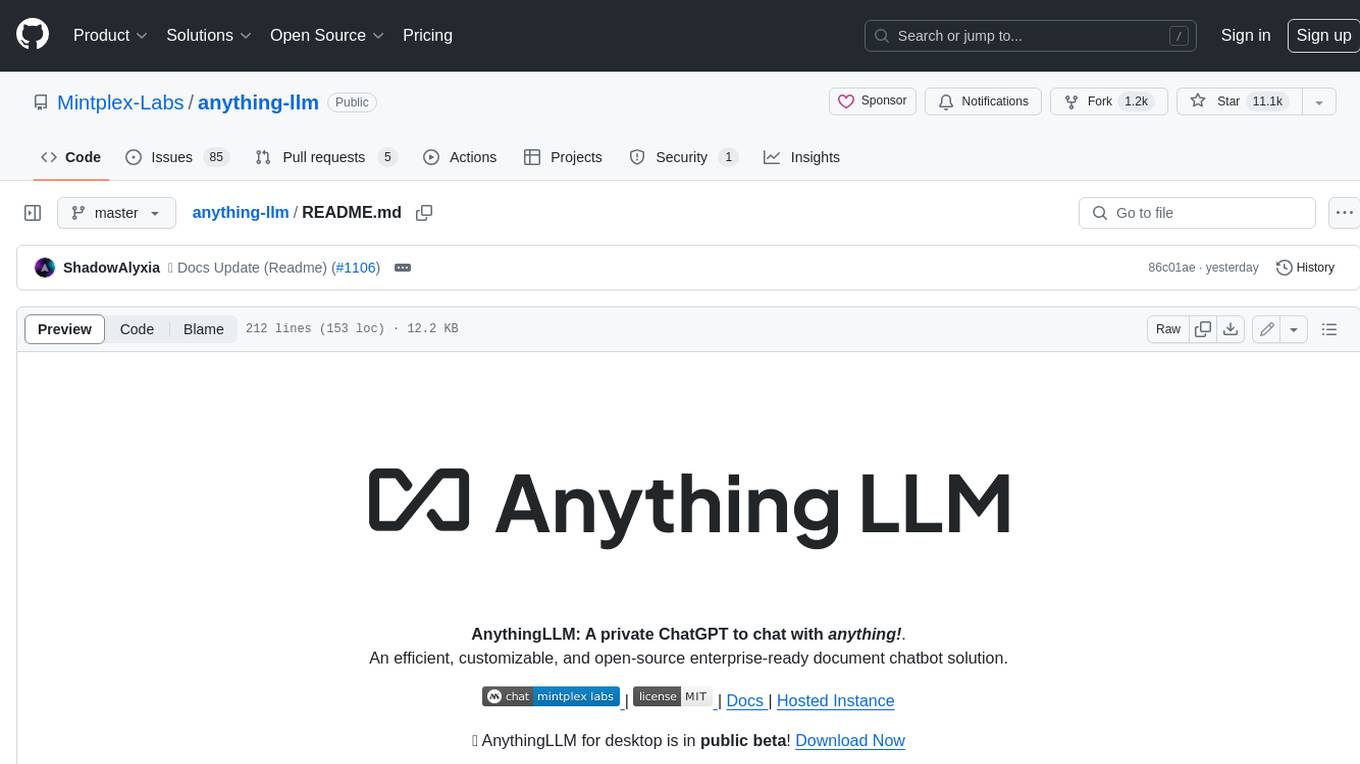
anything-llm
AnythingLLM is a full-stack application that enables you to turn any document, resource, or piece of content into context that any LLM can use as references during chatting. This application allows you to pick and choose which LLM or Vector Database you want to use as well as supporting multi-user management and permissions.

ai-guide
This guide is dedicated to Large Language Models (LLMs) that you can run on your home computer. It assumes your PC is a lower-end, non-gaming setup.

Magick
Magick is a groundbreaking visual AIDE (Artificial Intelligence Development Environment) for no-code data pipelines and multimodal agents. Magick can connect to other services and comes with nodes and templates well-suited for intelligent agents, chatbots, complex reasoning systems and realistic characters.
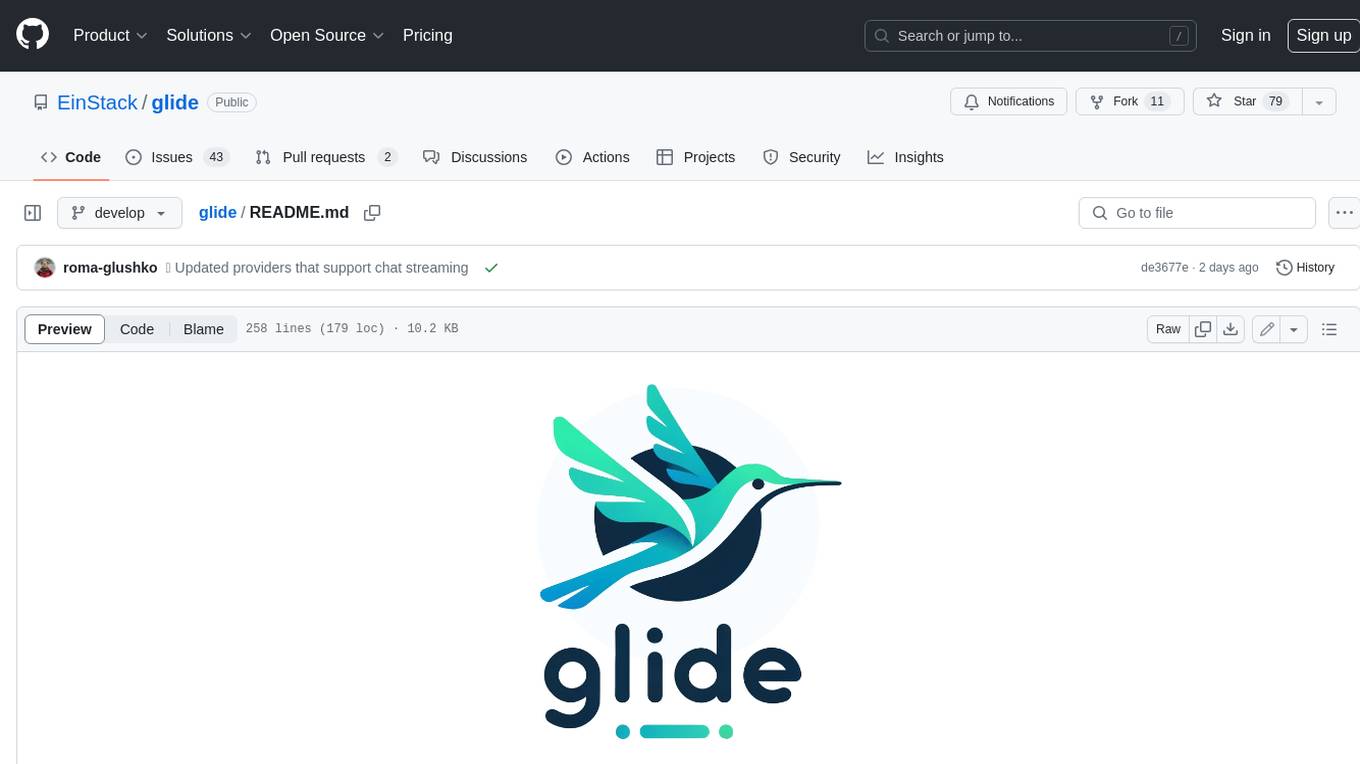
glide
Glide is a cloud-native LLM gateway that provides a unified REST API for accessing various large language models (LLMs) from different providers. It handles LLMOps tasks such as model failover, caching, key management, and more, making it easy to integrate LLMs into applications. Glide supports popular LLM providers like OpenAI, Anthropic, Azure OpenAI, AWS Bedrock (Titan), Cohere, Google Gemini, OctoML, and Ollama. It offers high availability, performance, and observability, and provides SDKs for Python and NodeJS to simplify integration.

chatbot-ui
Chatbot UI is an open-source AI chat app that allows users to create and deploy their own AI chatbots. It is easy to use and can be customized to fit any need. Chatbot UI is perfect for businesses, developers, and anyone who wants to create a chatbot.








